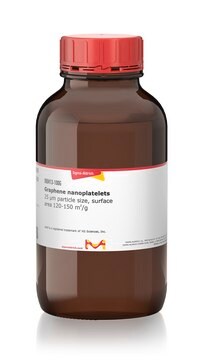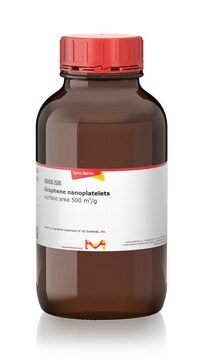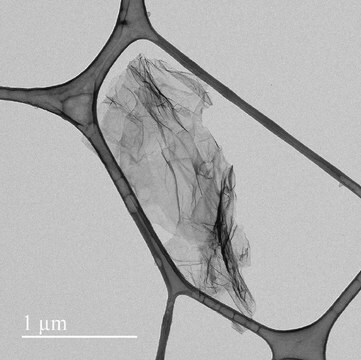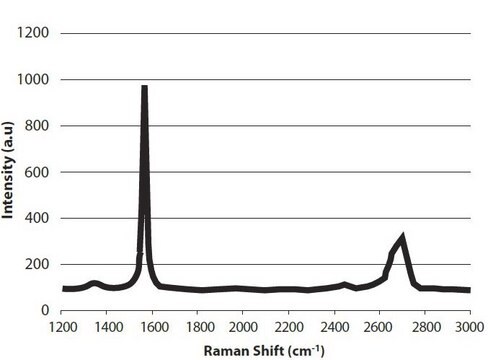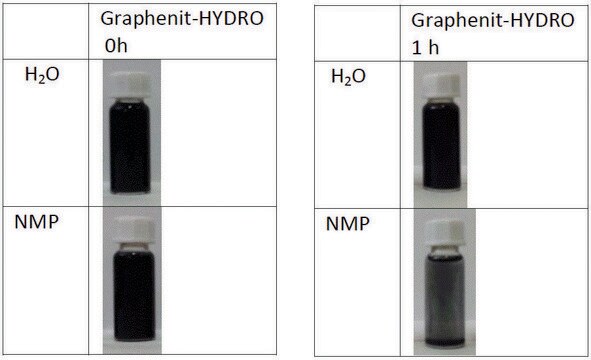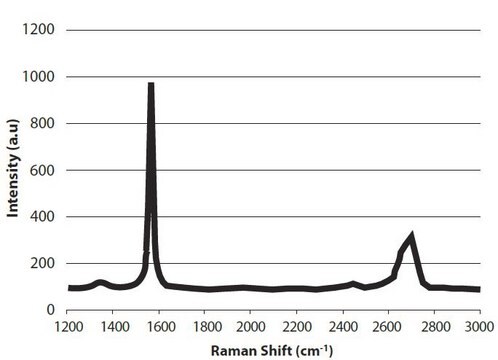900407
Graphene nanoplatelets
<2 μm particle size
Sinónimos:
GNPs, xGnP® graphene nanoplatelets-grade C-750
Iniciar sesiónpara Ver la Fijación de precios por contrato y de la organización
About This Item
Fórmula empírica (notación de Hill):
C
Número de CAS:
Peso molecular:
12.01
EC Number:
MDL number:
UNSPSC Code:
12141908
NACRES:
NA.23
Productos recomendados
description
relative gravity: 2.0-2.25 g/cm3
Quality Level
form
powder
surface area
750 m2/g
thickness
a few nm
particle size
<2 μm
bulk density
0.2‑0.4 g/cm3
SMILES string
[C]
InChI
1S/C
InChI key
OKTJSMMVPCPJKN-UHFFFAOYSA-N
¿Está buscando productos similares? Visita Guía de comparación de productos
Categorías relacionadas
General description
xGnP® graphene nanoplatelets are unique nanoparticles consisting of short stacks of graphene sheets having a platelet shape.
The unique size and platelet morphology of xGnP® graphene nanoplatelets makes these particles especially effective at providing barrier properties, while their pure graphitic composition makes them excellent electrical and thermal conductors. xGnP® graphene nanoplatelets can improve mechanical properties such as stiffness, strength, and surface hardness of the matrix material.
xGnP® graphene nanoplatelets are compatible with almost all polymers, and can be an active ingredient in inks or coatings as well as an excellent additive to plastics of all types. The unique manufacturing processes are non-oxidizing, so material has a pristine graphitic surface of sp2 carbon molecules that makes it especially suitable for applications requiring high electrical or thermal conductivity.
Grade C particles typically consist of aggregates of sub-micron platelets that have a particle diameter of less than 2 microns and a typical particle thickness of a few nanometers, depending on the surface area. In general, grade C particles show very high surface area and macro-porosity. Grade C particles are available in different grades with average surface areas of 300, 500 and 750 m2/g.
The unique size and platelet morphology of xGnP® graphene nanoplatelets makes these particles especially effective at providing barrier properties, while their pure graphitic composition makes them excellent electrical and thermal conductors. xGnP® graphene nanoplatelets can improve mechanical properties such as stiffness, strength, and surface hardness of the matrix material.
xGnP® graphene nanoplatelets are compatible with almost all polymers, and can be an active ingredient in inks or coatings as well as an excellent additive to plastics of all types. The unique manufacturing processes are non-oxidizing, so material has a pristine graphitic surface of sp2 carbon molecules that makes it especially suitable for applications requiring high electrical or thermal conductivity.
Grade C particles typically consist of aggregates of sub-micron platelets that have a particle diameter of less than 2 microns and a typical particle thickness of a few nanometers, depending on the surface area. In general, grade C particles show very high surface area and macro-porosity. Grade C particles are available in different grades with average surface areas of 300, 500 and 750 m2/g.
Application
- Ultracapacitor electrodes.
- Anode materials for lithium-ion batteries.
- Conductive additive for battery electrodes.
- Electrically conductive inks.
- Thermally conductive films and coatings.
- Additive for lightweight composites.
- Films or coatings for EMI shielding.
- Substrate for chemical and biochemical sensors.
- Barrier material for packaging.
- Additive for super-strong concrete.
- Additive for metal-matrix composites.
Other Notes
Graphene nanoplatelets have naturally occurring functional groups like ethers, carboxyls, or hydroxyls that can react with atmospheric humidity to form acids or other compounds. These functional groups are present on the edges of the particles and their wt% varies with particle size.
Surface area of 750 m2/g is an average surface area.
Surface area of 750 m2/g is an average surface area.
Legal Information
xGnP is a registered trademark of XG Sciences, Inc.
Storage Class
11 - Combustible Solids
wgk_germany
WGK 1
flash_point_f
Not applicable
flash_point_c
Not applicable
Elija entre una de las versiones más recientes:
¿Ya tiene este producto?
Encuentre la documentación para los productos que ha comprado recientemente en la Biblioteca de documentos.
Thermally Conductive Graphene-Polymer Composites: Size, Percolation, and Synergy Effects.
Shtein, et al.
Chemistry of Materials, 27(6), 2100-2106 (2015)
Mechanical properties of graphene nanoplatelet/epoxy composites.
King JA, et al.
Journal of Composite Materials, 49(6), 659-668 (2015)
Performance dependence of thermosyphon on the functionalization approaches: An experimental study on thermo-physical properties of graphene nanoplatelet-based water nanofluids.
Amiri A, et al.
Energy Conversion and Management, 92, 322-330 (2015)
In vivo profiling and visualization of cellular protein-lipid interactions using bifunctional fatty acids.
Per Haberkant et al.
Angewandte Chemie (International ed. in English), 52(14), 4033-4038 (2013-03-02)
Per Haberkant et al.
Biochimica et biophysica acta, 1841(8), 1022-1030 (2014-01-21)
Understanding biological processes at the mechanistic level requires a systematic charting of the physical and functional links between all cellular components. While protein-protein and protein-nucleic acid networks have been subject to many global surveys, other critical cellular components such as
Global Trade Item Number
| Número de referencia del producto (SKU) | GTIN |
|---|---|
| 900407-250G | 4061833244982 |
Nuestro equipo de científicos tiene experiencia en todas las áreas de investigación: Ciencias de la vida, Ciencia de los materiales, Síntesis química, Cromatografía, Analítica y muchas otras.
Póngase en contacto con el Servicio técnico